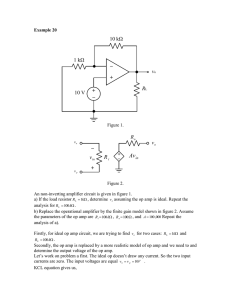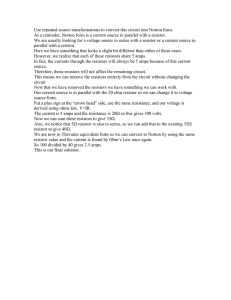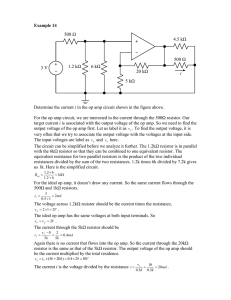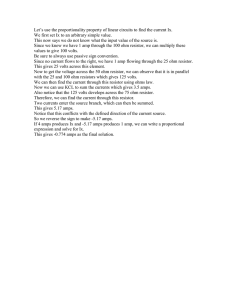Conditioning a Switch-mode Power Supply
advertisement
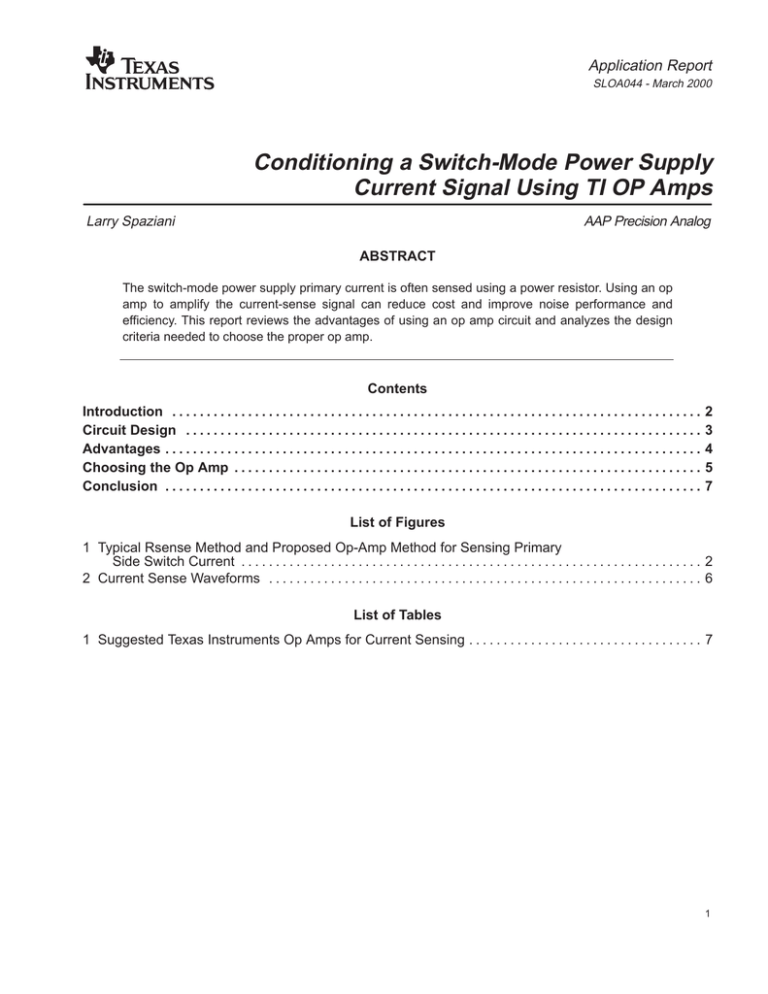
Application Report SLOA044 - March 2000 Conditioning a Switch-Mode Power Supply Current Signal Using TI OP Amps Larry Spaziani AAP Precision Analog ABSTRACT The switch-mode power supply primary current is often sensed using a power resistor. Using an op amp to amplify the current-sense signal can reduce cost and improve noise performance and efficiency. This report reviews the advantages of using an op amp circuit and analyzes the design criteria needed to choose the proper op amp. Contents Introduction . . . . . . . . . . . . . . . . . . . . . . . . . . . . . . . . . . . . . . . . . . . . . . . . . . . . . . . . . . . . . . . . . . . . . . . . . . . . . Circuit Design . . . . . . . . . . . . . . . . . . . . . . . . . . . . . . . . . . . . . . . . . . . . . . . . . . . . . . . . . . . . . . . . . . . . . . . . . . . Advantages . . . . . . . . . . . . . . . . . . . . . . . . . . . . . . . . . . . . . . . . . . . . . . . . . . . . . . . . . . . . . . . . . . . . . . . . . . . . . . Choosing the Op Amp . . . . . . . . . . . . . . . . . . . . . . . . . . . . . . . . . . . . . . . . . . . . . . . . . . . . . . . . . . . . . . . . . . . . Conclusion . . . . . . . . . . . . . . . . . . . . . . . . . . . . . . . . . . . . . . . . . . . . . . . . . . . . . . . . . . . . . . . . . . . . . . . . . . . . . . 2 3 4 5 7 List of Figures 1 Typical Rsense Method and Proposed Op-Amp Method for Sensing Primary Side Switch Current . . . . . . . . . . . . . . . . . . . . . . . . . . . . . . . . . . . . . . . . . . . . . . . . . . . . . . . . . . . . . . . . . . . 2 2 Current Sense Waveforms . . . . . . . . . . . . . . . . . . . . . . . . . . . . . . . . . . . . . . . . . . . . . . . . . . . . . . . . . . . . . . . 6 List of Tables 1 Suggested Texas Instruments Op Amps for Current Sensing . . . . . . . . . . . . . . . . . . . . . . . . . . . . . . . . . . 7 1 SLOA044 Introduction Switch-mode power supplies almost always require knowledge of the switching current, often sensed on the primary side of the power transformer. Current Sensing Solutions for Power Supply Designers1 reviews many methods for sensing the switched current. In lower-power switch-mode power supplies, the method most often used employes a sense resistor. The type of sense resistor used is often a high power, low inductance resistor that can add significant cost and power dissipation to the power supply design. This circuit is shown in Figure 1(a). PWMIC REF RLEB ISense + VS – CLEB + VSense – RSense GND A P A (a) Typical Rsense-Configured R3 PWMIC VREF A ISense + VS – GND R2 + TI OP AMP – A A + VSense – Ri Rf Cf RSense P A (b) Amplifying a Small Signal Using a TI Differential Amplifier Figure 1. Typical Rsense Method and Proposed Op-Amp Method for Sensing Primary Side Switch Current 1Current Sensing Solutions for Power Supply Designers, Bom Mammano, Unitrode Power Supply Seminar SEM-1200, 1997. 2 Conditioning a Switch-Mode Power Supply Current Signal Using TI OP Amps SLOA044 To overcome the cost and power dissipation of such power resistors, the circuit of Figure 1(b) is proposed. Using a differential amplifier made up of a low-power op amp and discrete resistors can result in several advantages including lower power dissipation (efficiency), noise immunity, cost, and programmability. Circuit Design A switch-mode power supply often switches current on the primary side of a transformer through a MOSFET and measures the primary current with a sense resistor (Rsense) as shown in Figure 1(a). The pulse width modulator IC (PWM) usually requires a current-sense signal (Vs) in order to provide short-circuit protection or for use in current mode control, or for both protection and control. The peak value of Vs depends on the PWM IC used, but it is typically 1 volt. The value of the sense resistor Rsense in Figure 1(a) is chosen based on the peak value of the primary-side current (Ipeak) and the required value of Vs. Therefore, Rsense is determined by: Rsense Vs + Ipeak The power dissipation in Rsense is based on the RMS value of the primary-side current (Irms), which depends on the peak value as well as on the waveshape and the duty cycle. The power dissipated is: Psense = Irms2 × Rsense As an example, let: Ipeak = 6.67 A Irms = 4 A Vs = 1 V These values result in an Rsense of 0.15 Ω, and a power dissipation in Rsense equal to 2.4 watts. Typically, a 5-W-rated resistor would be used in this application. The circuit of Figure 1(b) can be used to significantly reduce the cost and power dissipation of Rsense. First, let us review how the circuit of Figure 1(b) operates. This op-amp circuit is configured as a typical differential amplifier. The circuit operates by multiplying the differential sense signal (Vsense) by the differential gain of the op-amp circuit. If Rf = R3 and Ri = R2, this gain is: Gain + RfRi and Vs + Vsense Rf Ri Using the previous example, assume that the design goal is to use a lower-power sense resistor with a standard value, such as a 0.01-Ω resistor rated at 0.5 W, and to limit the dissipation of this resistor to no more than 0.25 W. From this information, the gain of the circuit can be calculated. Psense = Irms2 × Rsense = (4 Arms)2 × 0.01 Ω = 0.16 W Vsense = Ipeak × Rsense = 6.67 Apk × 0.01 Ω = 66.7 mV Gain Vs + 1 V + 15 + Vsense 66.7 mV Based on these results, let Rf = R3 = 15 kΩ and Ri = R2 = 1 kΩ in Figure 1(b). Conditioning a Switch-Mode Power Supply Current Signal Using TI OP Amps 3 SLOA044 Advantages Power Dissipation and Efficiency: The power dissipation of the sense resistor (Rsense) used in the second example results in an improvement of 2.4 W – 0.16 W = 2.24 W, which can result in a significant increase in efficiency as well. Board Area: The reduction in power rating results in a much smaller sense resistor. Consider for example the following sense resistors from Vishay Dale (www.vishay.com): WSR-3 3-watt surface-mount and the WSL 1/2-watt surface-mount resistors. The 3-watt device requires six times the board area of the 1/2 watt device and also needs significant copper area to dissipate the heat. The 1/2-watt resistor combined with a SOT-23 op amp and sense resistors result in approximately the same overall board area. Therefore, there is no significant advantage or disadvantage in board area. Cost: The cost tradeoff in this design is not just the cost of a high-power resistor versus the cost of the lower-power resistor plus the op-amp circuit. The following considerations can also be made regarding cost: • Reduced bill of materials and reduced-size inventory: custom or semicustom power-supply designs often choose sense resistors for the particular peak current and sense voltage required for each design. This can result in each individual power supply design requiring a unique value and power rating, resulting in many sense resistors in the company’s inventory. By utilizing one standard component, such as a 0.01-Ω, 0.5-watt resistor, each individual power supply design can be customized by changing the gain of the resistors around the op amp circuit. This also helps cost by allowing volume buying of one resistor. • Through-hole construction versus surface mount: The cost of manufacturing large through-hole power resistors should be compared to that of manufacturing standard surface-mount components such as lower-power sense resistors, ICs, and standard SMD resistors. • Thermal: The cost of additional cooling due to higher power dissipation should be considered. Programmability: The peak current of the switch-mode power supply can vary due to minor design or output specification changes, or for various other reasons. The ability to easily adjust the gain of the op amp circuit offers power-supply designers easy programmability by allowing changes to the circuit performance without having to change the sense resistor. These changes can be due to control-loop changes, or to power supply specification changes such as inputvoltage range or output-voltage and current changes, all of which affect the primary-side peak current. 4 Conditioning a Switch-Mode Power Supply Current Signal Using TI OP Amps SLOA044 Noise/performance: Several factors of this op amp design will improve performance with regard to noise immunity of the sensed current signal: • Lower-inductance resistors: lower-power-rated resistors have smaller bodies and are almost always surface-mount devices. This results in significantly-less series inductance, producing less ringing and fewer noise spikes on the current signal. • Differential sensing: differential sensing of the current signal results in an accurate measurement of the primary-side current without the ground variation (ground bounce) becoming a factor. This is not the case in the circuit of Figure 1(a), where the current sensing is single-ended. • Separating the grounds: the sense voltage (Vs) is often used by the PWM IC for both control and current limit protection. It is important to isolate the analog ground of the PWM IC from the noisy power ground of the sense resistor. The circuit of Figure 1(b) allows the designer to use grounds that vary slightly. It also allows the power-supply designer to place the sense resistor away from the PWM IC using the op amp to buffer the signal. The op amp should be ground-referenced to the same analog ground as the PWM IC. Choosing the Op Amp Size and number of channels: The op amp chosen is typically a single channel op amp as only one is required. Texas Instruments offers-single channel op amps in SOT-23, MSOP 8-pin, and SOIC 8-pin packages. Rail-to-rail input or output: The input signal to the op amp is the sense voltage (Vsense), which is ground referenced. However, the peak voltage of Vsense is typically very low and will not approach the positive power supply voltage of the op amp. Therefore, a rail-to-rail input op amp is not required. All of Texas Instruments single supply CMOS operational amplifiers can accept input signals as low as the ground. The output signal of the op amp is the Vs signal, which typically swings from 0 V to 1 V. The load current into the PWM IC is typically quite small, and therefore does not significantly limit the choice of op amps. Almost all of Texas Instruments single-supply CMOS op amps are capable of swinging to ground on the output. The load current into the PWM IC is typically quite small, and therefore will not significantly limit the choice of op amps. Powering the Op Amp: It is recommended to power the op amp from the reference output of the PWM IC used in the power supply. This reference is often 5.0 V, but can be lower. TI offers single-channel op amps that work from supply voltages as low as 2.5 V, such as the TLV2771. The reference output of the PWM IC (such as the UC384x and UCC380x family of PWM controllers) is often able to supply output drives of several milliamperes, which is adequate to power many op amps. The op amp should be grounded to the same analog ground used by the PWM IC. The current required by the op amp is the ICC current as well as the drive current. A feedback resistor (Rf) value between 10 kΩ and 100 kΩ is recommended to limit the drive current. Conditioning a Switch-Mode Power Supply Current Signal Using TI OP Amps 5 SLOA044 Slew rate and gain-bandwidth product: VSENSE trise VS tfall 1/fs Figure 2. Current Sense Waveforms Figure 2 shows a representation of Vsense, the current-sense signal across the sense resistor, and Vs, the filtered signal desired at the PWM IC. The leading edge of Vsense contains a spike that is due to parasitic elements in the power supply, including reverse recovery of diodes and capacitance of the MOSFET. This spike is undesirable and can be filtered out using the feedback capacitor Cf, as shown in Figure 1(b). The filter time-constant is often set to be three to four times the rise time of this spike. The filter’s pole must be set low enough to filter the leading edge spike, but not so low that the current ramp signal is distorted. The filter pole must therefore be set above the switching frequency (fs) of the switch-mode power supply. This can be expressed as: fc + (2 p 1 Rf Cf) + (8 p 1 trise) and fc w3 fs So, for a rise time (tr) of 100 ns and a 100-kHz switching frequency, this corner frequency would be set to 400 kHz. In this case the limiting factor is the time constant. Because the circuit filters out frequencies above fc, the gain-bandwidth (GBW) product of the op amp used can be easily calculated as: GBW w fc Gain + fc Rf Ri For the earlier example where the gain was set to 15, and with a 400-kHz corner frequency, the GBW for the desired op amp is calculated to be 6 MHz. 6 Conditioning a Switch-Mode Power Supply Current Signal Using TI OP Amps SLOA044 The slew rate (SR) of the waveform in Figure 2 can be determined by the falling slope, and is equal to Vpeak/tfall. However, the bandwidth of the circuit is limited significantly by the RC timeconstant of the pole. It can be assumed that the slew rate of the op amp should exceed the limitation of the filter time constant. Therefore, the slew rate can be determined by: SR Vpeak w Vpeak t + Rf Cf + Vpeak 2 p fc ń Volts second Continuing the earlier example, this would result in a SR of: SR w Vpeak 2 p fc +1 V p 2 400 kHz + 2.5 Vńms Conclusion The use of an op amp to differentially-amplify a current-sense signal in switch-mode power supplies offers cost, programmability, performance and power advantages. This paper discusses how to choose the proper op amp for this particular application. Several single-supply op amps suggested for this application are detailed in Table 1, with significant parameters listed. The TLV2771 and TLC081 are well suited for this application in 3.3-V and 5-V systems, respectively. Table 1. Suggested Texas Instruments Op Amps for Current Sensing OP AMP P/N SUPPLY VOLTAGE [V] SUPPLY CURRENT [mA] (MAX) SLEW RATE [V/us] (TYP) GBW [MHz] (TYP) SMD PACKAGES TLV2770 TLV2771 2.5–5.5 2.0 9.0 4.8 SOT–23, SOIC–8, MSOP–8 TLV2361 2.0–5.0 2.5 3.0 7.0 SOT–23 TLV2470 TLV2471 2.7–6.0 0.75 1.4 2.8 SOT–23, SOIC–8 TLV2231 2.7–10.0 1.2 1.6 2.0 TLC081 4.5–16.0 2.5 16.0 10.0 MSOP–8, SOIC–8 TLC2201 4.6–16.0 1.5 2.5 1.6 SOIC–8 Conditioning a Switch-Mode Power Supply Current Signal Using TI OP Amps 7 IMPORTANT NOTICE Texas Instruments and its subsidiaries (TI) reserve the right to make changes to their products or to discontinue any product or service without notice, and advise customers to obtain the latest version of relevant information to verify, before placing orders, that information being relied on is current and complete. All products are sold subject to the terms and conditions of sale supplied at the time of order acknowledgment, including those pertaining to warranty, patent infringement, and limitation of liability. TI warrants performance of its semiconductor products to the specifications applicable at the time of sale in accordance with TI’s standard warranty. Testing and other quality control techniques are utilized to the extent TI deems necessary to support this warranty. Specific testing of all parameters of each device is not necessarily performed, except those mandated by government requirements. Of course, customers are responsible for their applications using TI components. In order to minimize risks associated with the customer’s applications, adequate design and operating safeguards must be provided by the customer to minimize inherent or procedural hazards. TI assumes no liability for applications assistance or customer product design. TI does not warrant or represent that any license, either express or implied, is granted under any patent right, copyright, mask work right, or other intellectual property right of TI covering or relating to any combination, machine, or process in which such semiconductor products or services might be or are used. TI’s publication of information regarding any third party’s products or services does not constitute TI’s approval, warranty or endorsement thereof. Copyright 2000, Texas Instruments Incorporated


